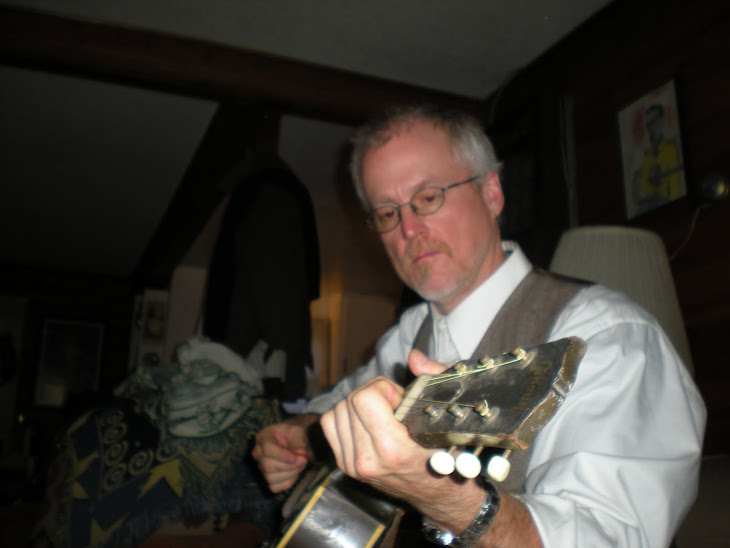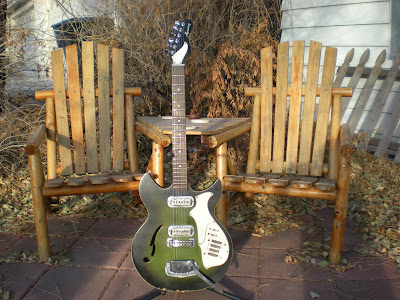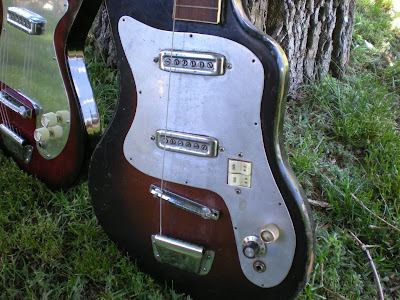Collectors own things simply to own them. To a collector, a sharpened knife is ruined, and any modification of whatever it is that they collect makes that example inferior to one in a completely stock state.
But, this isn't a post about collectors. This is a post about a guitar I just bought; a 1969 Harmony H-82G Rebel, just like the one I owned 30 years ago, when I was in college.
Here I am, playing that guitar circa 1980.
I have a soft spot for the thinline-style Harmony hollow bodied electric guitars. One of my all-time favorite guitars I have ever owned is a 1966 Harmony H-72, which is a slightly more upscale model than the Rebel. I bought my H-72 in unused condition back in 1997, and had it sitting in my coffee shop. Lots of people played that guitar there, and many wanted to buy it. Luckily, I never made a deal on it.
I've missed my Rebel, ever since the ex-wife talked me into selling it, along with about 10 other guitars, shortly after we bought our first house. She was of the opinion that all of those guitars were wasting space.
Anyway, I decided, a couple of years back, that I would like to get another Rebel, preferably the rarer Avocado Green model like I had in the old days. So, I started watching eBay, and bidding on them. I always seemed to get outbid by $5.00, because I have a maximum amount that I am willing to pay for one of these. Finally, last week, I ended up winning one.
I was ecstatic that I had finally scored one of these guitars.
It was a little rough around the edges, but it is over 30 years old. They can't all be as clean as my H-72. So, I was fine with it, cosmetically.
What I wasn't too happy with, though, was the tuners. While they appeared to be stock, they were actually a collection of parts from three different sets of tuners. Click the picture to make it big, and check out the screws and cogs on each tuner. The top tuner has a replacement cog (and post, which you can't see from here), but it at least works. The third tuner down has a replacement cog, which is the wrong size, and is almost impossible to turn. This rendered the G string virtually non-tunable.
I tuned the rest of the strings to the G, and plugged the guitar into my amp, and tested it out. The neck is great, the sound is fine, and playing it was like stepping back in time. It was everything I wanted...except tunable.
That was last Monday. I spent this week thinking about what I wanted to do. Should I find a set of six-on-a-plate original-style tuners and keep the guitar "stock", or should I just use the extra set of Telecaster-style tuners I picked up in Waynesboro, Tennessee, last summer?
Here's what I decided on:
I re-drilled the headstock for the nicer tuners and bolted them down, this afternoon. I'm not worried about resale value: I don't plan on reselling this guitar on the collector's market. It has found it's final home, more than likely. So, rather than replace the non-usable stock tuners with a newer version of what are, after all, sub-par units, I decided to make the guitar easier to deal with when I am playing it.
Here, for comparison's sake, are the Rebel and the slightly more upscale H-72. Some of the upgrades on the H-72, compared with the H-82 include the block inlays on the fingerboard, as opposed to the dots on the Rebel...
and a bound headstock, where the Rebel's headstock is unbound, along with nicer tuners (though they are still six-on-a-plate). The tuners on my H-72 are stock, but they still work well and I see no need to replace them until they become problematic. At that point, I will go with the same style tuners I installed on the Rebel.
I need to find some knobs for the sliding potentiometers. That's another place where I will end up with not-as-original parts, mainly because I can't find a source for the originals. It's unusual to see one of these with all of the knobs there, so it seems like some vintage guitar parts vendor would stock replacements, but none do. I suppose it's a pretty small market, even if 90% of the owners of these guitars are in need.
I love the green color, and the back of this guitar is in pretty decent shape. It's not unusual to see a lot of belt-buckle rash on these, as the paint is not particularly durable.
So, here's the full Monty, with the new tuners. I think we are going to make some interesting, if not beautiful, music, together...
x




















































